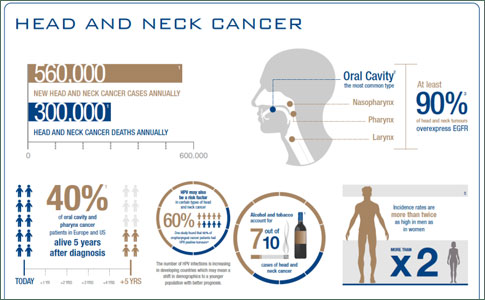Health Centers > Cancer Health Center > Head and Neck Cancer
Head and Neck Cancer
Head and neck cancer poses a serious health risk, with the American Cancer Society projecting that approximately 36,500 new cases of head and neck cancer will be diagnosed in the United States and that 11,000 American deaths will result from head and neck malignancies in 2003. While head and neck cancer accounts for only 3% of all new cancer cases and 2% of all cancer deaths in the United States annually, it is the fifth most common malignancy worldwide. Tobacco and alcohol are the primary etiologic agents in these cancers, suggesting prevention should be a primary public health goal in the field. Emerging evidence suggests that inherited factors and exposure to other agents play important roles, and these may help refine prevention strategies.
Head and Neck Cancer
Introduction
Incidence and Epidemiology
Etiology and Genetics
Hostopathology & Carcinogenesis
Differential Diagnosis
Treatment
Chemoprevention
Treatment Complications
Further Reading
Nearly identical percentages are reported from Britain, but head and neck cancers have a much greater impact in certain other parts of the world, especially where tobacco and/or betel nut chewing is common, and are the leading causes of cancer mortality worldwide. Despite improvements in diagnosis and local management, long-term survival rates in head and neck cancer have not increased significantly over the past 40 years and are among the lowest worldwide of the major cancers.
The problem is even worse for select populations such as African Americans, for whom survival rates have actually decreased. Oropharyngeal cancer, the largest subgroup of head and neck cancers, has a 5-year relative survival rate of only 59% for United States whites and 35% for blacks. Although early-stage head and neck cancers (especially laryngeal and oral cavity) have high cure rates, over 60% of head and neck cancer patients present with advanced disease. Cure rates decrease, of course, in locally advanced cases, whose probability of cure is inversely related to tumor size and even more so to the extent of regional node involvement.
Introduction
Epithelial carcinomas of the head and neck arise from the mucosal surfaces in the head and neck area and typically are squamous cell in origin. This category includes tumors of the paranasal sinuses, the oral cavity, and the nasopharynx, oropharynx, hypopharynx, and larynx. Tumors of the salivary glands differ from the more common carcinomas of the head and neck in etiology, histopathology, clinical presentation, and therapy.
Incidence and Epidemiology
The number of new cases of head and neck cancers in the United States was 38,530 in 2004, accounting for about 3% of adult malignancies. The worldwide incidence exceeds half a million cases annually. In North America and Europe, the tumors usually arise from the oral cavity, oropharynx, or larynx, whereas nasopharyngeal cancer is more common in the Mediterranean countries and in the Far East.
Etiology and Genetics
Alcohol and tobacco use are the most common risk factors for head and neck cancer in the United States. Smokeless tobacco is an etiologic agent for oral cancers. Other potential carcinogens include marijuana and occupational exposures such as nickel refining, exposure to textile fibers, and woodworking.
Esophageal Cancer overview
Esophageal cancer is a gastrointestinal malignancy with an insidious onset and a poor prognosis ...
Benign Esophageal Tumors
A variety of benign mass lesions can arise from different wall layers in the esophagus...
Laryngeal Cancer
Squamous cell carcinoma of the supraglottic larynx accounts for 35% of laryngeal cancers..
Cancer of the Oropharynx
Most oropharyngeal cancers are squamous cell carcinomas ..
Cancer of the Hypopharynx
Over 95% of hypopharyngeal cancers are squamous carcinomas ..
Colorectal Cancer
Colorectal cancer (CRC) continues to be one of the predominant cancers..
Carcinoma of the Mediastinum
Critical pathologic evaluation of mediastinal tumors is essential..
Carcinoma of the Anus
Anal cancer is an uncommon type of cancer that occurs in the anal canal..
Dietary factors may contribute. The incidence of head and neck cancer is highest in people with the lowest consumption of fruits and vegetables. Certain vitamins, including dietary carotenoids, may be protective; retinoids are being tested for prevention.
Cancer of the Nasal Cavity, Napopharynx, and Paranasal Sinuses
Cancer of the Oral Cavity
Cancer of the Oropharynx
Cancer of the Hypopharynx
Salivary Gland Tumors
Laryngeal Cancer (Cancer of the larynx)
Esophageal Cancer
Benign Esophageal Tumors
Some head and neck cancers may have a viral etiology. The DNA of human papillomavirus has been detected in the tissue of oral and tonsil cancers, and may predispose to oral cancer in the absence of tobacco and alcohol use. Epstein-Barr virus (EBV) infection is associated with nasopharyngeal cancer. Nasopharyngeal cancer occurs endemically in some countries of the Mediterranean and Far East, where EBV antibody titers can be measured to screen high-risk populations. Nasopharyngeal cancer has also been associated with consumption of salted fish.
No specific risk factors or environmental carcinogens have been identified for salivary gland tumors.
Squamous Cell Carcinoma of the Upper Aerodigestive Tract
Squamous Cell Carcinoma of the Upper Aerodigestive Tract
Incidence
Pathology
Clinical Features
Diagnosis
Treatment
Prognosis
Bibliography
The term head and neck cancer, if strictly applied, encompasses all cancers involving the head and neck region, including those involving the skin, brain, eyes, upper aerodigestive system, salivary glands, thyroid, and so forth. In actuality, this term is used to describe cancers arising from the mucosa of the upper aerodigestive tract, and for the purposes of this section it is these tumors that will be highlighted. The involved mucosa is that of the nose, paranasal sinuses, oral cavity, nasopharynx, oropharynx, hypopharynx, larynx, and cervical esophagus. While many histologic types of cancer may occur in these areas, by far the most common is squamous cell cancer.
Daily Head and Neck Cancer news
Two forms of radiosurgery for brain metastases are equally effective
Their study, published online Jan. 25, 2016 in Frontiers in Oncology, compared the two different…


